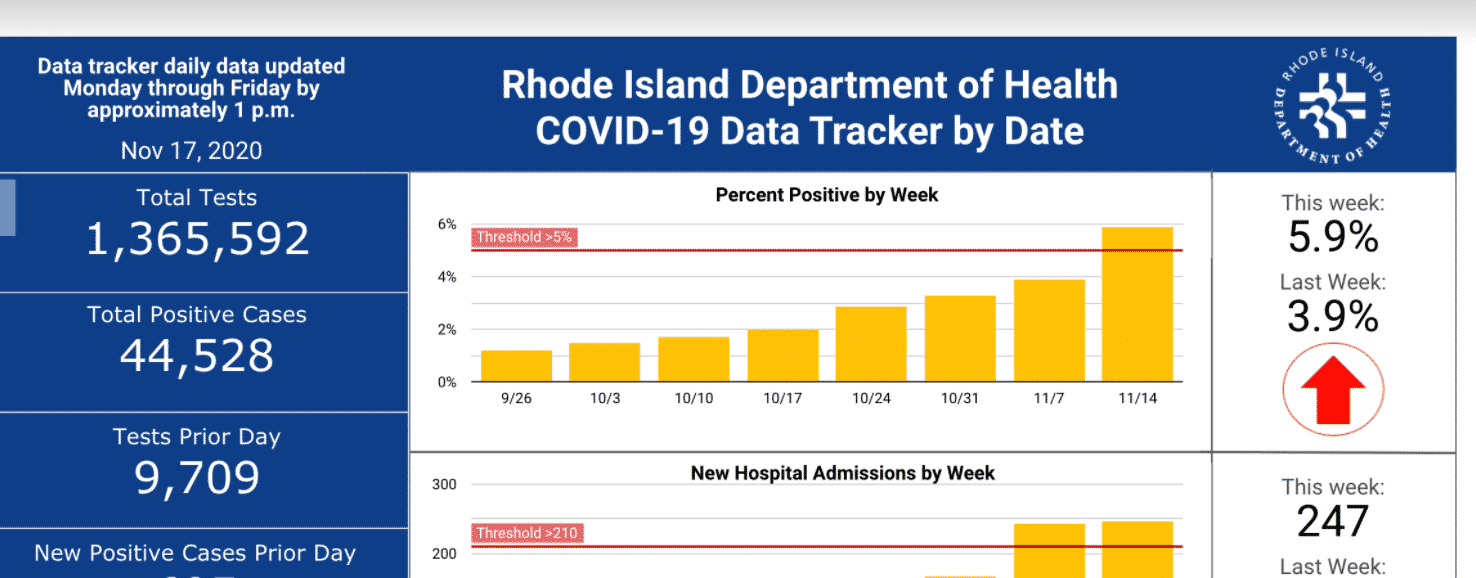
 PROVIDENCE — The recent uptick in COVID cases statewide has put the state’s percent positive threshold for returning to in-person schooling in question as teachers unions argue against keeping schools open.
PROVIDENCE — The recent uptick in COVID cases statewide has put the state’s percent positive threshold for returning to in-person schooling in question as teachers unions argue against keeping schools open.
Rhode Island set a percent-positive threshold of under 5% to open schools for in-person learning this year, on the advice of the country’s top virologist, Dr. Anthony Fauci. Fauci said Rhode Island only had a 2-3 percent infection rate, under the threshold for “green” states, with less than 10 cases per 100,000 people. Tuesday’s latest update puts Rhode Island at 5.9%. But will that metric change the way children are learning?
On Monday both the National Education Association Rhode Island and the Rhode Island Federation of Teachers and Health Professionals called for a “holiday pause” of in-person learning and a move toward distance learning for all Rhode Island K-12 students by Nov. 23.
“Certainly, if we had these numbers in August, we would not have reopened, so again, we need to wonder why it is OK now? It is not just the schools, we need to look at the entire community,” said NEARI President Larry Purtill. “The issue is keeping schools staffed safely and in many places, we cannot do that right now, so at minimum, let districts make individual decisions about in-person and distance learning. We do believe it would be better statewide.
Governor Gina Raimondo continues to reassure families that being in school is safe. Last week she said the rise in COVD cases in other counties is happening whether schools are open or not. She even cited that in Europe, schools are being kept open even during lockdowns “because we all now know that schools are not major spreaders and children suffer mightily, and in the long-run, if we close our schools,” she said.
Raimondo’s office did not respond to a request for comment on this story.
Superintendent of Schools Philip Thornton says schools will likely remain open unless the rise in cases impacts staffing levels.
“Health experts have related that the safest place for a student during a pandemic is in a school,” Thornton said. “Based on the data, schools are not super spreaders for COVID 19. Having said this, staffing schools remains a challenge as cases identified in the school community/contact tracing and quarantining continue to cause staffing shortages.”
But delays in contact tracing make it harder to know exactly what the impact is on students, according to Purtill, who says in many cases contact tracing is delayed by days. And while he says Thornton is correct in what the science says, those students do live in the community, see other family members, have jobs and be in contact with others, and then enter school buildings.
“Until we can get contact tracing under control and are able to test students and staff regularly, we need to hit pause so the three weeks we are asking for do not become the months of January and February,” he said.
Warwick is slated to make a return to full week in-person learning for Kindergarten through Grade 5 in early December, but the latest data may put that on hold. Assistant Superintendent Lynn Dambruch told School Committee members Tuesday night that may change with the new rates.
Earlier this week Former Rhode Island Department of Health Director Dr. Michael Fine, M.D. said as community transmission goes up, the likelihood of staff and teachers becoming infected, and schools becoming a source of infection, continues to rise. That could impact keeping schools open. And this increase in the percent positive threshold rate is going to come into play, he said.
“People are setting thresholds and then ignoring them. There are many competing sorts of demands,” Fine said. “One is people want schools to stay open for a number of reasons most of which are economic and [other demands] are educational.”
Fine went on to say that he finds it amazing that as a society we have accepted letting college students get tested twice a week but we aren’t testing teachers, firefighters and police twice weekly.
“We’ve allowed this very two-tiered situation to occur and I don’t think we really don’t know the truth about schools and I don’t think we have enough time to study with some precision,” he said.
This is a test
